House of Wittelsbach
This article has multiple issues. Please help improve it or discuss these issues on the talk page. (Learn how and when to remove these messages)
|
| House of Wittelsbach | |
|---|---|
 | |
| Parent house | Luitpoldings(?) |
| Country | Bavaria, Cologne, Germany, Greece, Hungary, Kalmar Union, Sweden, Palatinate, Lusatia |
| Founded | 11th century |
| Founder | Otto I |
| Current head | Franz, Duke of Bavaria |
| Final ruler | Ludwig III |
| Titles | |
| Deposition | 13 November 1918 |
| Cadet branches |
|

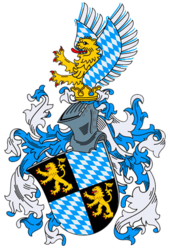
| Bavarian Royalty House of Wittelsbach |
|---|
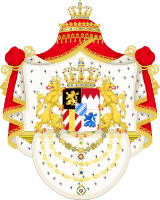 |
| Maximilian I Joseph |
|
| Ludwig I |
|
| Maximilian II |
| Ludwig II |
| Otto I |
| Ludwig III |
|
The House of Wittelsbach (German: Haus Wittelsbach) is a former Bavarian dynasty, with branches that have ruled over territories including the Electorate of Bavaria, the Electoral Palatinate, the Electorate of Cologne, Holland, Zeeland, Sweden (with Swedish-ruled Finland), Denmark, Norway, Hungary, Bohemia, and Greece. Their ancestral lands of Bavaria and the Palatinate were prince-electorates, and the family had three of its members elected emperors and kings of the Holy Roman Empire. They ruled over the Kingdom of Bavaria which was created in 1805 and continued to exist until 1918.
The House of Windsor, the reigning royal house of the British monarchy, are descendants of Sophia of Hanover (1630–1714), a Wittelsbach Princess of the Palatinate by birth and Electress of Hanover by marriage, who had inherited the succession rights of the House of Stuart and passed them on to the House of Hanover.[1][2]
History
[edit]When Otto I, Count of Scheyern died in 1072, his third son Otto II, Count of Scheyern acquired Wittelsbach Castle (near Aichach). The Counts of Scheyern left Scheyern Castle (constructed around 940) in 1119 for Wittelsbach Castle and the former was given to monks to establish Scheyern Abbey. The origins of the Counts of Scheyern are unclear. Some speculative theories link them to Margrave Henry of Schweinfurt and his father Berthold, whose background is also disputed. Some speculate that the Schweinfurters may be descendants of the Luitpolding dynasty, the Bavarian dukes of the 10th century.
The Wittelsbach Conrad of Scheyern-Dachau, a great-grandson of Otto I, Count of Scheyern, became Duke of Merania in 1153 and was succeeded by his son Conrad II. It was the first duchy held by the Wittelsbach family (until 1180/82).
Otto I's eldest son Eckhard I, Count of Scheyern was father of the count palatine of Bavaria, Otto IV (died 1156), who was the first Count of Wittelsbach and whose son Otto was invested with the Duchy of Bavaria in 1180 after the fall of Henry the Lion and hence the first Bavarian ruler from the House of Wittelsbach. Duke Otto's son Louis I, Duke of Bavaria acquired the Electorate of the Palatinate in 1214.
Throughout history, members of the royal house have reigned as Dukes of Merania (1153–1180/82); Dukes, Electors, and Kings of Bavaria (1180–1918); Counts Palatine of the Rhine (1214–1803 and 1816–1918); Margraves of Brandenburg (1323–1373); Counts of Holland, Hainaut, and Zeeland (1345–1433); Elector-Archbishops of Cologne (1583–1761); Dukes of Jülich and Berg (1614–1794/1806); Kings of Sweden (1441–1448 and 1654–1720); and Dukes of Bremen-Verden (1654–1719).
The family also provided two Holy Roman Emperors (1328–1347/1742–1745), one King of the Romans (1400–1410), two Anti-Kings of Bohemia (1619–20/1742–43), one King of Hungary (1305–1308), one King of Denmark and Norway (1440–1448), and one King of Greece (1832–1862).
Bavaria and Palatinate within the Holy Roman Empire
[edit]
The Wittelsbach dynasty ruled the German territories of Bavaria from 1180 to 1918 and the Electorate of the Palatinate from 1214 until 1805. In both countries they had succeeded rulers from the House of Welf. The Duchy of Bavaria was elevated to the Electorate of Bavaria in 1623, and in 1806, Napoleon elevated it to the Kingdom of Bavaria. In 1815, the majority of the Palatinate was annexed by the Grand Duchy of Baden, with the remainder becoming the Circle of the Rhine.
On Duke Otto II's death in 1253, his sons divided the Wittelsbach possessions between them: Henry became Duke of Lower Bavaria, and Louis II Duke of Upper Bavaria and Count Palatine of the Rhine. When Henry's branch died out in 1340 the Emperor Louis IV, a son of Duke Louis II, reunited the duchy.
The family provided two Holy Roman Emperors: Louis IV (1314–1347) and Charles VII (1742–1745), both members of the Bavarian branch of the family, and one German King with Rupert of Germany (1400–1410), a member of the Palatinate branch.
The House of Wittelsbach split into these two branches in 1329: Under the Treaty of Pavia, Emperor Louis IV granted the Palatinate including the Bavarian Upper Palatinate to his brother Duke Rudolf's descendants, Rudolf II, Rupert I and Rupert II. Rudolf I in this way became the ancestor of the older (Palatinate) line of the Wittelsbach dynasty, which returned to power also in Bavaria in 1777 after the extinction of the younger (Bavarian) line, the descendants of Louis IV.
Through the efforts of Louis IV, the Wittelsbachs controlled the Duchy of Bavaria, the Electorate of the Palatine, the County of Tyrol, the Margraviate of Brandenburg, the County of Holland, County of Zeeland and the County of Hainault. This gave them a chance to dominate the Empire as the previous imperial houses of Hohenstaufen, Salians, Ottonians and Carolingians had. However, in the next generation they were outmaneuvered in Imperial politics by the Habsburgs and the most importantly by the Luxemburgs who both held compact and large possessions in the Duchy of Austria for the former and the Kingdom of Bohemia for the latter that allowed them to expand eastward.
Bavarian branch
[edit]The Bavarian branch kept the Duchy of Bavaria until its extinction in 1777.
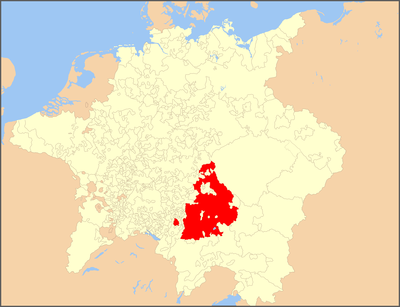
The Wittelsbach Emperor Louis IV acquired Brandenburg (1323), Tyrol (1342), Holland, Zeeland and Hainaut (1345) for his House but he had also released the Upper Palatinate for the Palatinate branch of the Wittelsbach in 1329. His six sons succeeded him as Duke of Bavaria and Count of Holland and Hainaut in 1347. The Wittelsbachs lost the Tyrol with the death of Duke Meinhard and the following Peace of Schärding – the Tyrol was finally renounced to the Habsburgs in 1369. In 1373 Otto, the last Wittelsbach regent of Brandenburg, released the country to the House of Luxembourg. On Duke Albert's death in 1404, he was succeeded in the Netherlands by his eldest son, William. A younger son, John III, became Prince-Bishop of Liège. However, on William's death in 1417, a war of succession broke out between John and William's daughter Jacqueline of Hainaut. This last episode of the Hook and Cod wars finally left the counties in Burgundian hands in 1433. Emperor Louis IV had reunited Bavaria in 1340 but from 1349 onwards Bavaria was split among the descendants of Louis IV, who created the branches Bavaria-Landshut, Bavaria-Straubing, Bavaria-Ingolstadt and Bavaria-Munich. With the Landshut War of Succession Bavaria was reunited in 1505 against the claim of the Palatinate branch under the Bavarian branch Bavaria-Munich.
From 1549 to 1567 the Wittelsbach owned the County of Kladsko in Bohemia.
Strictly Catholic by upbringing, the Bavarian dukes became leaders of the German Counter-Reformation. From 1583 to 1761, the Bavarian branch of the dynasty provided the Prince-electors and Archbishops of Cologne and many other bishops of the Holy Roman Empire, namely Liège (1581–1763). Wittelsbach princes served at times as Bishops of Regensburg, Freising, Münster, Hildesheim, Paderborn and Osnabrück, and as Grand Master of the Teutonic Order.
In 1623 under Maximilian I the Bavarian dukes were invested with the electoral dignity and the duchy became the Electorate of Bavaria. His grandson Maximilian II Emanuel, Elector of Bavaria served also as Governor of the Habsburg Netherlands (1692–1706) and as Duke of Luxembourg (1712–1714). His son Emperor Charles VII also claimed the throne of Bohemia (1741–1743). With the death of Charles' son Maximilian III Joseph, Elector of Bavaria the Bavarian branch died out in 1777.
Palatinate branch
[edit]
The Palatinate branch kept the Palatinate until 1918, having succeeded also to Bavaria in 1777. With the Golden Bull of 1356 the Counts Palatine were invested with the electoral dignity, their county became the Electorate of the Palatinate. Princes of the Palatinate branch served as bishops of the Empire and also as Elector-Archbishop-Electors of Mainz and Archbishop-Electors of Trier.
After the death of the Wittelsbach king Rupert of Germany in 1410 the Palatinate lands began to split under numerous branches of the family such as Neumarkt, Simmern, Zweibrücken, Birkenfeld, Neuburg and Sulzbach. When the senior branch of the Palatinate branch died out in 1559, the electorate passed to Frederick III of Simmern, a staunch Calvinist, and the Palatinate became one of the major centers of Calvinism in Europe, supporting Calvinist rebellions in both the Netherlands and France.
The Neuburg cadet branch of the Palatinate branch also held the Duchy of Jülich and Berg from 1614 onwards: When the last duke of Jülich-Cleves-Berg died without direct heirs in 1609, the War of the Jülich succession broke out, ended by the 1614 Treaty of Xanten, which divided the separate duchies between Palatinate-Neuburg and the Margraviate of Brandenburg. Jülich and Berg fell to the Wittelsbach Count Palatine Wolfgang William of Neuburg.
In 1619, the Protestant Frederick V, Elector Palatine became King of Bohemia but was defeated by the Catholic Maximilian I, Elector of Bavaria, a member of the Bavarian branch. As a result, the Upper Palatinate had to be ceded to the Bavarian branch in 1623, along with the Imperial office of Arch-Steward. When the Thirty Years' War concluded with the Treaty of Münster (also called the Peace of Westphalia) in 1648, a new additional electorate was created for the Count Palatine of the Rhine, along with the new office of Imperial Arch-Treasurer. During their exile Frederick's sons, especially Prince Rupert of the Rhine, gained fame in England.

The house of Palatinate of Zweibrücken-Kleeburg as heir to the Swedish throne ruled simultaneously the Duchy of Bremen-Verden (1654–1719).
In 1685, the Simmern line died out, and the Catholic Philip William, Count Palatine of Neuburg inherited the Palatinate (and also Duke of Jülich and Berg). During the reign of Johann Wilhelm (1690–1716) the Electoral residence moved to Düsseldorf in Berg. His brother and successor Charles III Philip, Elector Palatine moved the Palatinate's capital back to Heidelberg in 1718 and then to Mannheim in 1720. To strengthen the union of all lines of the Wittelsbach dynasty Charles Philip organized a wedding on 17 January 1742 when his granddaughters were married to Charles Theodore of Palatinate-Sulzbach and to the Bavarian prince Clement. In the imperial election a few days later Charles III Philip voted for his Bavarian cousin Prince-Elector Charles Albert. After extinction of the Neuburg branch in 1742, the Palatinate was inherited by Duke Charles Theodore of the branch Palatinate-Sulzbach.
After the extinction of the Bavarian branch in 1777, a succession dispute and the brief War of the Bavarian Succession, the Palatinate-Sulzbach branch under Elector Charles Theodore succeeded also in Bavaria.
With the death of Charles Theodore in 1799 all Wittelsbach land in Bavaria and the Palatinate was reunited under Maximilian IV Joseph, a member of the branch Palatinate-Zweibrücken-Birkenfeld. At the time there were two surviving branches of the Wittelsbach family: Palatinate-Zweibrücken-Birkenfeld (headed by Maximilian Joseph) and Palatinate-Birkenfeld-Gelnhausen (headed by Count Palatine William). Maximilian Joseph inherited Charles Thedore's title of Elector of Bavaria, while William was compensated with the title of Duke in Bavaria. The form Duke in Bavaria was selected because in 1506 primogeniture had been established in the House of Wittelsbach resulting in there being only one reigning Duke of Bavaria at any given time. Maximillian Joseph assumed the title of king as Maximilian I Joseph on 1 January 1806. The new king still served as a Prince-elector until the Kingdom of Bavaria left the Holy Roman Empire (1 August 1806).
Kingdom of Bavaria, 1806–1918
[edit]The Bavarian Army was involved in the Austrian defeat at Hohenlinden, and General Jean Victor Marie Moreau once more occupied Munich. By the Treaty of Lunéville (9 February 1801), Bavaria lost the Palatinate and the duchies of Zweibrücken and Jülich. In view of the scarcely disguised ambitions and intrigues of the Austrian court, prime minister Montgelas now believed that the interests of Bavaria lay in a frank alliance with the French Republic; he succeeded in overcoming the reluctance of Maximilian Joseph; and, on 24 August, a separate treaty of peace and alliance with France was signed at Paris, which allied Bavaria with France.
The 1805 Peace of Pressburg (now Bratislava) between Emperor Napoleon of France and Francis II, Holy Roman Emperor, as a consequence of the French victory over the Russians and Austrians at the Battle of Austerlitz (2 December), allowed Maximilian to raise Bavaria to the status of a kingdom. Accordingly, Maximilian proclaimed himself king on 1 January 1806. The King still served as an elector until Bavaria seceded from the Holy Roman Empire on 1 August 1806, joining the Confederation of the Rhine. The Duchy of Berg was ceded to Napoleon only in 1806.
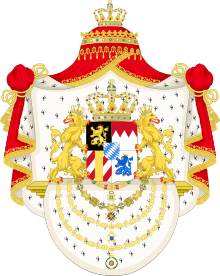

The Congress of Vienna 1814−15 led to the establishment of significant territorial gains for the Kingdom of Bavaria. Although the Duchy of Berg remained lost, almost all of Franconia, previously ruled by a number of Prince-bishops, as well as parts of Swabia, which had belonged to various mediatised secular and ecclesiastic princes, came under Bavarian rule. In both areas a number of formerly free imperial cities were also integrated into the kingdom. The previously heavily fragmented Palatinate territory was rounded off and partially moved. Smaller, mostly ecclesiastical territories on the southern border with Austria were also added. In this way, the border of Bavaria, which largely still exists today, was redefined and the state grew by more than a third in size.
Under Maximilian's descendants, Bavaria became the third most powerful German state, behind only Prussia and Austria. When the German Empire was formed in 1871, Bavaria became the new empire's second most powerful state after Prussia. The Wittelsbachs reigned as kings of Bavaria until the German Revolution of 1918–1919. On 12 November 1918 Ludwig III issued the Anif declaration (German: Anifer Erklärung) at Anif Palace in Austria,[3] in which he released his soldiers and officials from their oath of loyalty to him and ended the 738-year rule of the House of Wittelsbach in Bavaria.[4] The republican movement thereupon declared a republic.
Activities during the Nazi regime, 1933–1945
[edit]Before and during the Second World War, the Wittelsbachs were anti-Nazi. Crown Prince Rupert had earned Hitler's eternal enmity by opposing the Beer Hall Putsch in 1923. In 1933, shortly after Hitler's rise to power, he protested against the appointment of governors at the head of the federal states and thus the de facto abolition of German federalism. In 1938, he emigrated to Italy and, after the German Army occupied Italy in September 1943, went into hiding in Florence.
His son, Albrecht, Duke of Bavaria, initially left Germany for Hungary with his family, but was eventually arrested by the Gestapo in October 1944, after Germany had occupied Hungary in March. With his wife, four children and three half-sisters, he was sent to a series of Nazi concentration camps, including Oranienburg, Flossenbürg and Dachau.[5][6] Badly hit by hunger and disease, the family barely survived.[7] At the end of April 1945, they were liberated by the United States Third Army.
Current position of the head of the house
[edit]Albrecht's eldest son, Franz von Bayern (Francis of Bavaria) is the current head of the house.
In the course of the division of state and house assets after the end of the kingdom, the Wittelsbach Compensation Fund (Wittelsbacher Ausgleichsfonds) was established through a compromise in 1923 and the Wittelsbach State Foundation for Art and Science was established by the former Crown Prince Rupprecht of Bavaria. The Wittelsbach State Foundation received the Wittelsbach family's art treasures acquired before 1804 and has since been the owner, although not the manager, of a large part of the holdings of the ancient and classical art museums in Munich, while more recent art collections came into the possession of the compensation fund, into which most of the possessions from the former Wittelsbach House Property Fund were transferred in 1923, including art treasures and collections (in particular the art collection of King Ludwig I, today mostly in the museums Alte Pinakothek and Neue Pinakothek and in the Glyptothek in Munich), the Secret House Archives (today a department of the Bavarian State Archives) and the former royal castles of Berg, Hohenschwangau (including the Museum of the Bavarian Kings), Berchtesgaden and Grünau hunting lodge.[8]
The respective head of the House of Wittelsbach appoints a board of up to 8 directors of the foundation Wittelsbach Compensation Fund. He also appoints one of the 3 board members of the Wittelsbach State Foundation for Art and Science, while the other two are a representative of the Bavarian Ministry of Culture and a museum specialist appointed by the latter.[9] There are around 13,500 cultural items belonging to the Wittelsbach State Foundation while another 43,000 are owned by the Wittelsbach Compensation Fund, mainly shown in museums and collections such as the Pinakotheken.[10]

The former Bavarian Royal Family receives around 14 million Euros in payments annually from the proceeds of the Wittelsbach Compensation Fund which also owns agricultural and forestry lands, while its main source of income is urban real estate in Munich.[11] The respective head of the family decides on their distribution and use.[12] He has the right to live in the castles mentioned. While Albrecht lived in Berg Palace from 1949 until the end of his life in 1996, his son and successor Franz primarily uses the side wing of the Nymphenburg Palace that is available to him. The administration of the House of Wittelsbach is also based there.
The private assets of the House of Wittelsbach include the castles of Tegernsee Abbey, Wildenwart (near Frasdorf), Leutstetten (near Starnberg) and Kaltenberg as well as agricultural lands and forestry with an area of 12,500 hectares, real estate and industrial shares. These include two breweries that only became significant after the Second World War: the Ducal Bavarian Brewery of Tegernsee and the König Ludwig Schlossbrauerei. Since 2011, the Nymphenburg Porcelain Manufactory is also owned by a member of the family.
The head of the house is also Grand Master of the Wittelsbach House Orders, the Royal Order of Saint George for the Defense of the Immaculate Conception, the Order of Saint Hubert and the Order of Theresa.
Duke Franz maintained the tradition founded by his father of holding a large annual reception with a sit-down dinner at Nymphenburg Palace. Around 1,500 mostly changing guests from state politics, municipalities, churches and sciences, art and medicine as well as friends and relatives are invited.[13] He also invites smaller groups of changing guests to Berchtesgaden Castle to discuss specific topics that are important to him. His 80th birthday party, in 2013, was held at the Schleissheim Palace near Munich. The party was attended by 2,500 guests including the then-incumbent Minister-President of Bavaria, Horst Seehofer.
In addition to numerous honorary positions in Bavaria, including many cultural and scientific institutions, Franz was also a member of the European Foundation for the Imperial Cathedral of Speyer in the State of Rhineland-Palatinate for many years, a position that his younger brother Duke Max Emanuel in Bavaria, has since taken over,[14] through which the House of Wittelsbach still maintains a connection to one of its former main territories, the Electoral Palatinate.
Reign outside the Holy Roman Empire
[edit]With Duke Otto III of Lower Bavaria, who was a maternal grandson of Béla IV of Hungary and was elected anti-king of Hungary and Croatia as Bela V (1305–1308) the Wittelsbach dynasty came to power outside the Holy Roman Empire for the first time. Otto had abdicated the Hungarian throne by 1308.
Palatinate branch
[edit]United Kingdom
[edit]The Bill of Rights 1689 and the Act of Settlement 1701 excluded non-Protestants from inheriting the throne of Great Britain, making Sophia of Hanover, a born princess of the House of Palatinate-Simmern, the heir presumptive upon Anne's death. Sophia died two months before Anne, however, and Sophia's eldest son George I of Great Britain succeeded the throne in 1714.[15][16] In this way, the House of Hanover inherited the British crown. It remained on the throne until the death of Queen Victoria in 1901.
The line of Jacobite succession, which recognises the right for a Catholic monarch from the House of Stuart, acknowledges Franz, Hereditary Prince of Bavaria to be the rightful heir as "Francis II". However, no individual since Henry Benedict Stuart has publicly taken up the claim.
Kingdom of Sweden
[edit]
Christopher III of the House of Palatinate-Neumarkt was king of Denmark, Sweden, and Norway in 1440/1442–1448, but left no descendants.
The House of Palatinate-Zweibrücken succeeded to the monarchy of Sweden again 1654–1720 when Queen Christina of Sweden abdicated her throne on 5 June 1654 in favour of her cousin Charles X Gustav. Under Charles X, Charles XI, Charles XII, Sweden reached its greatest power (see Swedish Empire). Charles XII was succeeded by his sister Ulrika Eleonora.
Sweden reached its largest territorial extent under the rule of Charles X after the Treaty of Roskilde in 1658. Charles's son Charles XI rebuilt the economy and refitted the army. His legacy to his son Charles XII was one of the finest arsenals in the world, a large standing army, and a large fleet. Charles XII was a skilled military leader and tactician. However, although he was also skilled as a politician, he was reluctant in making peace. While Sweden achieved several large scale military successes early on, and won the most battles, the Great Northern War eventually ended in Sweden's defeat and the end of the Swedish Empire. Charles was succeeded to the Swedish throne by his sister, Ulrika Eleonora. Her abdication in favour of her husband Frederick I in 1720 marked the end of Wittelsbach rule in Sweden.
Kingdom of Greece
[edit]
Prince Otto of Bavaria was chosen by the London Conference of 1832 to be king of newly independent Greece. This was confirmed by the Treaty of Constantinople, whereby Greece became a new independent kingdom under the protection of the Great Powers (the United Kingdom, France and the Russian Empire).
Throughout his reign, Otto faced political challenges concerning Greece's financial weakness and the role of the government in the affairs of the Church. The politics of Greece of this era was based on affiliations with the three Great Powers, and Otto's ability to maintain the support of the powers was key to his remaining in power. To remain strong, Otto had to play the interests of each of the Great Powers’ Greek adherents against the others, while not aggravating the Great Powers. Otto's standing amongst Greeks suffered when Greece was blockaded by the British Royal Navy in 1850 and 1853 to stop Greece from attacking the Ottoman Empire during the Crimean War. As a result, there was an assassination attempt on his wife Queen Amalia in 1861. In 1862, Otto was deposed while in the countryside, and in 1863, the Greek National Assembly elected George I of the House of Glücksburg, aged only 17, King of the Hellenes, marking the end of Wittelsbach rule in Greece.
-
Propylaea in Munich, monument for the secundogeniture of the Wittelsbach in Greece
Bavarian branch
[edit]Joseph Ferdinand, a son of Maximilian II Emanuel, was the favored choice of England and the Netherlands to succeed as the ruler of Spain, and Charles II of Spain chose him as his heir. Due to the unexpected death of Joseph Ferdinand in 1699 the Wittelsbachs did not come to power in Spain, leaving the Spanish Succession uncertain again.
Major members of the family
[edit]-
Louis IV, Holy Roman Emperor (1314–1347)
-
Isabeau of Bavaria, Queen of France (1370–1435)
-
Frederick V, Elector Palatine, King of Bohemia (1596–1632)
-
Maximilian II Emanuel, Elector of Bavaria (1662–1726)
-
Charles XII, King of Sweden (1682–1718)
-
Charles VII, Holy Roman Emperor (1742–1745)
-
Otto, King of Greece (1815–1867)
-
Ludwig II, King of Bavaria (1845–1886)
Patrilineal descent
[edit]Duke Franz's patriline is the line from which he is descended father to son. Patrilineal descent is the principle behind membership in royal houses, as it can be traced back through the generations.
- Heinrich I, Count of Pegnitz, 1000–1043
- Otto I, Count of Scheyern, 1020–1072
- Eckhard I, Count of Scheyern, 1044-1088
- Otto IV, Count of Wittelsbach, 1083–1156
- Otto I, Duke of Bavaria, 1117–1183
- Louis I, Duke of Bavaria, 1173–1231
- Otto II Wittelsbach, Duke of Bavaria, 1206–1253
- Louis II, Duke of Bavaria, 1229–1294
- Rudolf I, Duke of Bavaria, 1274–1319
- Adolf, Count Palatine of the Rhine, 1300–1327
- Rupert II, Elector Palatine, 1325–1398
- Rupert of Germany, 1352–1410
- Stephen, Count Palatine of Simmern-Zweibrücken, 1385–1459
- Louis I, Count Palatine of Zweibrücken, 1424–1489
- Alexander, Count Palatine of Zweibrücken, 1462–1514
- Louis II, Count Palatine of Zweibrücken, 1502–1532
- Wolfgang, Count Palatine of Zweibrücken, 1526–1569
- Charles I, Count Palatine of Zweibrücken-Birkenfeld, 1560–1600
- Christian I, Count Palatine of Birkenfeld-Bischweiler, 1598–1654
- Christian II, Count Palatine of Zweibrücken, 1637–1717
- Christian III, Count Palatine of Zweibrücken, 1674–1735
- Count Palatine Frederick Michael of Zweibrücken, 1724–1767
- Maximilian I Joseph of Bavaria, 1756–1825
- Ludwig I of Bavaria, 1786–1868
- Luitpold, Prince Regent of Bavaria, 1821–1912
- Ludwig III of Bavaria, 1845–1921
- Rupprecht, Crown Prince of Bavaria, 1869–1955
- Albrecht, Duke of Bavaria, 1905–1996
- Franz, Duke of Bavaria, b. 1933
Bavarian branch
[edit]- Louis V, Margrave of Brandenburg, Duke of Bavaria and Count of Tyrol (1323–1361)
- Albert I, Duke of Bavaria, Count of Holland and Hainaut (1347–1404)
- Isabeau de Bavière (1371–1435), queen-consort of France
- Ernest, Duke of Bavaria (1397–1438) duke of Bavaria-Munich
- Albert III, Duke of Bavaria (1438–1460) duke of Bavaria-Munich
- Jacqueline, Countess of Hainaut and Holland (1417–1432)
- Albert IV, Duke of Bavaria (1465–1508)
- William IV, Duke of Bavaria (1508–1550), co-regent Louis X from 1516 to 1545
- Louis X, Duke of Bavaria (1516–1545)
- Albert V, Duke of Bavaria (1550–1579)
- Maximilian I, Elector of Bavaria (1597–1651)
- Maria Anna, Dauphine of France (1660–1690)
- Maximilian II Emanuel, Elector of Bavaria (1662–1726)
- Duchess Violante Beatrice of Bavaria (1673–1731), Hereditary Princess of Tuscany and Governess of Siena,
- Clemens August of Bavaria (1700–1761)
- Maria Antonia of Bavaria (1724–1780)
Palatinate branch
[edit]- Frederick I, Elector Palatine (1451–1476)
- Frederick III, Elector Palatine (1559–1576)
- Frederick V, Elector Palatine (1610–1623), King of Bohemia (the "Winter King")
- Charles I Louis, Elector Palatine (1648–1680)
- Prince Rupert of the Rhine (1619–1682)
- Sophia of the Palatine (1630–1714), daughter of Frederick V, Heiress to the British throne, mother of King George I of Great Britain
- Elizabeth Charlotte, Princess Palatine (1652–1722)
- Johann Wilhelm, Elector Palatine (1690–1718), his wife Anna Maria Luisa de' Medici being the last scion of the House of Medici
- King Ludwig I of Bavaria (1825–1848)
- Princess Sophie of Bavaria (1805–1872), Archduchess of Austria
- Elisabeth in Bavaria (1837–1898) ("Sisi"), Empress of Austria
- Ludwig II of Bavaria (1864–1886)
- Marie Sophie (1841–1925), last queen of the Kingdom of the Two Sicilies
- Elisabeth of Bavaria (1876–1965), queen-consort of Albert I of Belgium
- Sophie, Hereditary Princess of Liechtenstein, b. 1967
Scandinavian kings
[edit]- Christopher of Denmark, Norway and Sweden, reigned 1440–1448
- Charles X Gustav of Sweden, reigned 1654–1660
- Charles XI of Sweden, reigned 1660–1697
- Charles XII of Sweden, reigned 1697–1718
- Ulrika Eleonora of Sweden, reigned 1718–1720
Family tree
[edit]Antecedents of the Wittelsbachs and Early Dukes of Bavaria
[edit]| House of Wittelsbach | |||||||||||||||||||||||||||||||||||||||||||||||||||||||||||||||||||||||||||||||||||||||||||||||||||||||||||||||||||||||||||||||||||||||||||||||||||||||||||||||||||||||||||||||||||||||||||||||||||||||||||||||||||||||||||||||||||||||||||||||||||||||||||||||||||||||||||||||||||||||||||||||||||||||||||||||||||||||||||||||||||||||||||||||||||||||||||||||||||||||||||||||||||||||||||||||||||||||||||||||||||||||||||||||||||||||||||||||||||||||||||||||||||||||||||||||||||||||||||||||||||||||||||||||||||||||||||||||||||||||||||||||||||||||||||||||||||||||||||||||||||||||||||||||||||||||||||||||||||||||||||||||||||||||||||||||||||||||||||||||||||||||||||||||||||||||||||||||||||||||||||||||||||||||||||||||||||||||||||||||||||||||||||||||||||||||||||||||||||||||||||||||||||||||||||||||||||||||||||||||||||||||||||||||||||||||||||||||||||||||||||||||||||||||||||||||||||||||||||||||||||||||||||||||||||||||||||||||||||||||||||||||||||||||||||||||||||||||||||||||||||||||||||||||||||||||||||||||||||||||
|---|---|---|---|---|---|---|---|---|---|---|---|---|---|---|---|---|---|---|---|---|---|---|---|---|---|---|---|---|---|---|---|---|---|---|---|---|---|---|---|---|---|---|---|---|---|---|---|---|---|---|---|---|---|---|---|---|---|---|---|---|---|---|---|---|---|---|---|---|---|---|---|---|---|---|---|---|---|---|---|---|---|---|---|---|---|---|---|---|---|---|---|---|---|---|---|---|---|---|---|---|---|---|---|---|---|---|---|---|---|---|---|---|---|---|---|---|---|---|---|---|---|---|---|---|---|---|---|---|---|---|---|---|---|---|---|---|---|---|---|---|---|---|---|---|---|---|---|---|---|---|---|---|---|---|---|---|---|---|---|---|---|---|---|---|---|---|---|---|---|---|---|---|---|---|---|---|---|---|---|---|---|---|---|---|---|---|---|---|---|---|---|---|---|---|---|---|---|---|---|---|---|---|---|---|---|---|---|---|---|---|---|---|---|---|---|---|---|---|---|---|---|---|---|---|---|---|---|---|---|---|---|---|---|---|---|---|---|---|---|---|---|---|---|---|---|---|---|---|---|---|---|---|---|---|---|---|---|---|---|---|---|---|---|---|---|---|---|---|---|---|---|---|---|---|---|---|---|---|---|---|---|---|---|---|---|---|---|---|---|---|---|---|---|---|---|---|---|---|---|---|---|---|---|---|---|---|---|---|---|---|---|---|---|---|---|---|---|---|---|---|---|---|---|---|---|---|---|---|---|---|---|---|---|---|---|---|---|---|---|---|---|---|---|---|---|---|---|---|---|---|---|---|---|---|---|---|---|---|---|---|---|---|---|---|---|---|---|---|---|---|---|---|---|---|---|---|---|---|---|---|---|---|---|---|---|---|---|---|---|---|---|---|---|---|---|---|---|---|---|---|---|---|---|---|---|---|---|---|---|---|---|---|---|---|---|---|---|---|---|---|---|---|---|---|---|---|---|---|---|---|---|---|---|---|---|---|---|---|---|---|---|---|---|---|---|---|---|---|---|---|---|---|---|---|---|---|---|---|---|---|---|---|---|---|---|---|---|---|---|---|---|---|---|---|---|---|---|---|---|---|---|---|---|---|---|---|---|---|---|---|---|---|---|---|---|---|---|---|---|---|---|---|---|---|---|---|---|---|---|---|---|---|---|---|---|---|---|---|---|---|---|---|---|---|---|---|---|---|---|---|---|---|---|---|---|---|---|---|---|---|---|---|---|---|---|---|---|---|---|---|---|---|---|---|---|---|---|---|---|---|---|---|---|---|---|---|---|---|---|---|---|---|---|---|---|---|---|---|---|---|---|---|---|---|---|---|---|---|---|---|---|---|---|---|---|---|---|---|---|---|---|---|---|---|---|---|---|---|---|---|---|---|---|---|---|---|---|---|---|---|---|---|---|---|---|---|---|---|---|---|---|---|---|---|---|---|---|---|---|---|---|---|---|---|---|---|---|---|---|---|---|---|---|---|---|---|---|---|---|---|---|---|---|---|---|---|---|---|---|---|---|---|---|---|---|---|---|---|---|---|---|---|---|---|---|---|---|---|---|---|---|---|---|---|---|---|---|---|---|---|---|---|---|---|---|---|---|---|---|---|---|---|---|---|---|---|---|---|---|---|---|---|---|---|---|---|---|---|---|---|---|---|---|---|---|---|---|---|---|---|---|---|---|---|---|---|---|---|---|---|---|---|---|---|---|---|---|---|---|---|---|---|---|---|---|---|---|---|---|---|---|---|---|---|---|---|---|---|---|---|---|---|---|---|---|---|---|---|---|---|---|---|---|---|---|---|---|---|---|---|---|---|---|---|---|---|---|---|---|---|---|---|---|---|---|---|---|---|---|---|---|---|---|---|---|---|---|---|---|---|---|---|---|---|---|---|---|---|---|---|---|---|---|---|---|---|---|---|---|---|---|---|---|---|---|---|---|---|---|---|---|---|---|---|---|---|---|---|---|---|---|---|---|---|---|---|---|---|---|---|---|---|---|---|---|---|---|---|---|---|---|---|---|---|---|---|---|---|---|---|---|---|---|---|---|---|---|---|---|---|---|---|---|---|---|---|---|---|---|---|---|---|---|---|---|---|---|---|---|---|---|---|---|---|---|---|---|---|---|---|---|---|---|---|---|---|---|---|---|---|---|---|---|---|---|---|---|---|---|---|---|---|---|---|---|---|---|---|---|---|---|---|---|---|---|---|---|---|---|---|---|---|---|---|---|---|---|---|---|---|---|---|---|---|---|---|---|---|---|
| |||||||||||||||||||||||||||||||||||||||||||||||||||||||||||||||||||||||||||||||||||||||||||||||||||||||||||||||||||||||||||||||||||||||||||||||||||||||||||||||||||||||||||||||||||||||||||||||||||||||||||||||||||||||||||||||||||||||||||||||||||||||||||||||||||||||||||||||||||||||||||||||||||||||||||||||||||||||||||||||||||||||||||||||||||||||||||||||||||||||||||||||||||||||||||||||||||||||||||||||||||||||||||||||||||||||||||||||||||||||||||||||||||||||||||||||||||||||||||||||||||||||||||||||||||||||||||||||||||||||||||||||||||||||||||||||||||||||||||||||||||||||||||||||||||||||||||||||||||||||||||||||||||||||||||||||||||||||||||||||||||||||||||||||||||||||||||||||||||||||||||||||||||||||||||||||||||||||||||||||||||||||||||||||||||||||||||||||||||||||||||||||||||||||||||||||||||||||||||||||||||||||||||||||||||||||||||||||||||||||||||||||||||||||||||||||||||||||||||||||||||||||||||||||||||||||||||||||||||||||||||||||||||||||||||||||||||||||||||||||||||||||||||||||||||||||||||||||||||||||
The Palatine/Elder Branch
[edit]
The Bavarian/Younger Branch
[edit]| House of Wittelsbach in Bavaria | |||||||||||||||||||||||||||||||||||||||||||||||||||||||||||||||||||||||||||||||||||||||||||||||||||||||||||||||||||||||||||||||||||||||||||||||||||||||||||||||||||||||||||||||||||||||||||||||||||||||||||||||||||||||||||||||||||||||||||||||||||||||||||||||||||||||||||||||||||||||||||||||||||||||||||||||||||||||||||||||||||||||||||||||||||||||||||||||||||||||||||||||||||||||||||||||||||||||||||||||||||||||||||||||||||||||||||||||||||||||||||||||||||||||||||||||||||||||||||||||||||||||||||||||||||||||||||||||||||||||||||||||||||||||||||||||||||||||||||||||||||||||||||||||||||||||||||||||||||||||||||||||||||||||||||||||||||||||||||||||||||||||||||||||||||||||||||||||||||||||||||||||||||||||||||||||||||||||||||||||||||||||||||||||||||||||||||||||||||||||||||||||||||||||||||||||||||||||||||||||||||||||||||||||||||||||||||||||||||||||||||||||||||||||||||||||||||||||||||||||||||||||||||||||||||||||||||||||||||||||||||||||||||||||||||||||||||||||||||||||||||||||||||||||||||||||||||||||||||||||
|---|---|---|---|---|---|---|---|---|---|---|---|---|---|---|---|---|---|---|---|---|---|---|---|---|---|---|---|---|---|---|---|---|---|---|---|---|---|---|---|---|---|---|---|---|---|---|---|---|---|---|---|---|---|---|---|---|---|---|---|---|---|---|---|---|---|---|---|---|---|---|---|---|---|---|---|---|---|---|---|---|---|---|---|---|---|---|---|---|---|---|---|---|---|---|---|---|---|---|---|---|---|---|---|---|---|---|---|---|---|---|---|---|---|---|---|---|---|---|---|---|---|---|---|---|---|---|---|---|---|---|---|---|---|---|---|---|---|---|---|---|---|---|---|---|---|---|---|---|---|---|---|---|---|---|---|---|---|---|---|---|---|---|---|---|---|---|---|---|---|---|---|---|---|---|---|---|---|---|---|---|---|---|---|---|---|---|---|---|---|---|---|---|---|---|---|---|---|---|---|---|---|---|---|---|---|---|---|---|---|---|---|---|---|---|---|---|---|---|---|---|---|---|---|---|---|---|---|---|---|---|---|---|---|---|---|---|---|---|---|---|---|---|---|---|---|---|---|---|---|---|---|---|---|---|---|---|---|---|---|---|---|---|---|---|---|---|---|---|---|---|---|---|---|---|---|---|---|---|---|---|---|---|---|---|---|---|---|---|---|---|---|---|---|---|---|---|---|---|---|---|---|---|---|---|---|---|---|---|---|---|---|---|---|---|---|---|---|---|---|---|---|---|---|---|---|---|---|---|---|---|---|---|---|---|---|---|---|---|---|---|---|---|---|---|---|---|---|---|---|---|---|---|---|---|---|---|---|---|---|---|---|---|---|---|---|---|---|---|---|---|---|---|---|---|---|---|---|---|---|---|---|---|---|---|---|---|---|---|---|---|---|---|---|---|---|---|---|---|---|---|---|---|---|---|---|---|---|---|---|---|---|---|---|---|---|---|---|---|---|---|---|---|---|---|---|---|---|---|---|---|---|---|---|---|---|---|---|---|---|---|---|---|---|---|---|---|---|---|---|---|---|---|---|---|---|---|---|---|---|---|---|---|---|---|---|---|---|---|---|---|---|---|---|---|---|---|---|---|---|---|---|---|---|---|---|---|---|---|---|---|---|---|---|---|---|---|---|---|---|---|---|---|---|---|---|---|---|---|---|---|---|---|---|---|---|---|---|---|---|---|---|---|---|---|---|---|---|---|---|---|---|---|---|---|---|---|---|---|---|---|---|---|---|---|---|---|---|---|---|---|---|---|---|---|---|---|---|---|---|---|---|---|---|---|---|---|---|---|---|---|---|---|---|---|---|---|---|---|---|---|---|---|---|---|---|---|---|---|---|---|---|---|---|---|---|---|---|---|---|---|---|---|---|---|---|---|---|---|---|---|---|---|---|---|---|---|---|---|---|---|---|---|---|---|---|---|---|---|---|---|---|---|---|---|---|---|---|---|---|---|---|---|---|---|---|---|---|---|---|---|---|---|---|---|---|---|---|---|---|---|---|---|---|---|---|---|---|---|---|---|---|---|---|---|---|---|---|---|---|---|---|---|---|---|---|---|---|---|---|---|---|---|---|---|---|---|---|---|---|---|---|---|---|---|---|---|---|---|---|---|---|---|---|---|---|---|---|---|---|---|---|---|---|---|---|---|---|---|---|---|---|---|---|---|---|---|---|---|---|---|---|---|---|---|---|---|---|---|---|---|---|---|---|---|---|---|---|---|---|---|---|---|---|---|---|---|---|---|---|---|---|---|---|---|---|---|---|---|---|---|---|---|---|---|---|---|---|---|---|---|---|---|---|---|---|---|---|---|---|---|---|---|---|---|---|---|---|---|---|---|---|---|---|---|---|---|---|---|---|---|---|---|---|---|---|---|---|---|---|---|---|---|---|---|---|---|---|---|---|---|---|---|---|---|---|---|---|---|---|---|---|---|---|---|---|---|---|---|---|---|---|---|---|---|---|---|---|---|---|---|---|---|---|---|---|---|---|---|---|---|---|---|---|---|---|---|---|---|---|---|---|---|---|---|---|---|---|---|---|---|---|---|---|---|---|---|---|---|---|---|---|---|---|---|---|---|---|---|---|---|---|---|---|---|---|---|---|---|---|---|---|---|---|---|---|---|---|---|---|---|---|---|---|---|---|---|---|---|---|---|---|---|---|---|---|---|---|---|---|---|---|---|---|---|---|---|---|---|---|---|---|---|---|---|---|---|---|---|---|---|---|---|---|---|---|---|---|---|---|---|---|---|---|---|---|---|---|---|---|
|
The colours denote the Dukes, Counts and Electors over the following regions of Bavaria and under the following circumstances:
| |||||||||||||||||||||||||||||||||||||||||||||||||||||||||||||||||||||||||||||||||||||||||||||||||||||||||||||||||||||||||||||||||||||||||||||||||||||||||||||||||||||||||||||||||||||||||||||||||||||||||||||||||||||||||||||||||||||||||||||||||||||||||||||||||||||||||||||||||||||||||||||||||||||||||||||||||||||||||||||||||||||||||||||||||||||||||||||||||||||||||||||||||||||||||||||||||||||||||||||||||||||||||||||||||||||||||||||||||||||||||||||||||||||||||||||||||||||||||||||||||||||||||||||||||||||||||||||||||||||||||||||||||||||||||||||||||||||||||||||||||||||||||||||||||||||||||||||||||||||||||||||||||||||||||||||||||||||||||||||||||||||||||||||||||||||||||||||||||||||||||||||||||||||||||||||||||||||||||||||||||||||||||||||||||||||||||||||||||||||||||||||||||||||||||||||||||||||||||||||||||||||||||||||||||||||||||||||||||||||||||||||||||||||||||||||||||||||||||||||||||||||||||||||||||||||||||||||||||||||||||||||||||||||||||||||||||||||||||||||||||||||||||||||||||||||||||||||||||||||||
The Royal House of the Kingdom of Bavaria
[edit]| Royal House of Bavaria/Wittelsbach | |||||||||||||||||||||||||||||||||||||||||||||||||||||||||||||||||||||||||||||||||||||||||||||||||||||||||||||||||||||||||||||||||||||||||||||||||||||||||||||||||||||||||||||||||||||||||||||||||||||||||||||||||||||||||||||||||||||||||||||||||||||||||||||||||||||||||||||||||||||||||||||||||||||||||||||||||||||||||||||||||||||||||||||||||||||||||||||||||||||||||||||||||||||||||||||||||||||||||||||||||||||||||||||||||||||||||||||||||||||||||||||||||||||||||||||||||||||||||||||||||||||||||||||||||||||||||||||||||||||||||||||||||||||||||||||||||||||||||||||||||||||||||||||||||||||||||||||||||||||||||||||||||||||||||||||||||||||||||||||||||||||||||||||||||||||||||||||||||||||||||||||||||||||||||||||||||||||||||||||||||||||||||||||||||||||||||||||||||||||||||||||||||||||||||||||||||||||||||||||||||||||||||||||||||||||||||||||||||||||||||||||||||||||||||||||||||||||||||||||||||||||||||||||||||||||||||||||||||||||||||||||||||||||||||||||||||||||||||||||||||||||||||||||||||||||||||||||||||||||||
|---|---|---|---|---|---|---|---|---|---|---|---|---|---|---|---|---|---|---|---|---|---|---|---|---|---|---|---|---|---|---|---|---|---|---|---|---|---|---|---|---|---|---|---|---|---|---|---|---|---|---|---|---|---|---|---|---|---|---|---|---|---|---|---|---|---|---|---|---|---|---|---|---|---|---|---|---|---|---|---|---|---|---|---|---|---|---|---|---|---|---|---|---|---|---|---|---|---|---|---|---|---|---|---|---|---|---|---|---|---|---|---|---|---|---|---|---|---|---|---|---|---|---|---|---|---|---|---|---|---|---|---|---|---|---|---|---|---|---|---|---|---|---|---|---|---|---|---|---|---|---|---|---|---|---|---|---|---|---|---|---|---|---|---|---|---|---|---|---|---|---|---|---|---|---|---|---|---|---|---|---|---|---|---|---|---|---|---|---|---|---|---|---|---|---|---|---|---|---|---|---|---|---|---|---|---|---|---|---|---|---|---|---|---|---|---|---|---|---|---|---|---|---|---|---|---|---|---|---|---|---|---|---|---|---|---|---|---|---|---|---|---|---|---|---|---|---|---|---|---|---|---|---|---|---|---|---|---|---|---|---|---|---|---|---|---|---|---|---|---|---|---|---|---|---|---|---|---|---|---|---|---|---|---|---|---|---|---|---|---|---|---|---|---|---|---|---|---|---|---|---|---|---|---|---|---|---|---|---|---|---|---|---|---|---|---|---|---|---|---|---|---|---|---|---|---|---|---|---|---|---|---|---|---|---|---|---|---|---|---|---|---|---|---|---|---|---|---|---|---|---|---|---|---|---|---|---|---|---|---|---|---|---|---|---|---|---|---|---|---|---|---|---|---|---|---|---|---|---|---|---|---|---|---|---|---|---|---|---|---|---|---|---|---|---|---|---|---|---|---|---|---|---|---|---|---|---|---|---|---|---|---|---|---|---|---|---|---|---|---|---|---|---|---|---|---|---|---|---|---|---|---|---|---|---|---|---|---|---|---|---|---|---|---|---|---|---|---|---|---|---|---|---|---|---|---|---|---|---|---|---|---|---|---|---|---|---|---|---|---|---|---|---|---|---|---|---|---|---|---|---|---|---|---|---|---|---|---|---|---|---|---|---|---|---|---|---|---|---|---|---|---|---|---|---|---|---|---|---|---|---|---|---|---|---|---|---|---|---|---|---|---|---|---|---|---|---|---|---|---|---|---|---|---|---|---|---|---|---|---|---|---|---|---|---|---|---|---|---|---|---|---|---|---|---|---|---|---|---|---|---|---|---|---|---|---|---|---|---|---|---|---|---|---|---|---|---|---|---|---|---|---|---|---|---|---|---|---|---|---|---|---|---|---|---|---|---|---|---|---|---|---|---|---|---|---|---|---|---|---|---|---|---|---|---|---|---|---|---|---|---|---|---|---|---|---|---|---|---|---|---|---|---|---|---|---|---|---|---|---|---|---|---|---|---|---|---|---|---|---|---|---|---|---|---|---|---|---|---|---|---|---|---|---|---|---|---|---|---|---|---|---|---|---|---|---|---|---|---|---|---|---|---|---|---|---|---|---|---|---|---|---|---|---|---|---|---|---|---|---|---|---|---|---|---|---|---|---|---|---|---|---|---|---|---|---|---|---|---|---|---|---|---|---|---|---|---|---|---|---|---|---|---|---|---|---|---|---|---|---|---|---|---|---|---|---|---|---|---|---|---|---|---|---|---|---|---|---|---|---|---|---|---|---|---|---|---|---|---|---|---|---|---|---|---|---|---|---|---|---|---|---|---|---|---|---|---|---|---|---|---|---|---|---|---|---|---|---|---|---|---|---|---|---|---|---|---|---|---|---|---|---|---|---|---|---|---|---|---|---|---|---|---|---|---|---|---|---|---|---|---|---|---|---|---|---|---|---|---|---|---|---|---|---|---|---|---|---|---|---|---|---|---|---|---|---|---|---|---|---|---|---|---|---|---|---|---|---|---|---|---|---|---|---|---|---|---|---|---|---|---|---|---|---|---|---|---|---|---|---|---|---|---|---|---|---|---|---|---|---|---|---|---|---|---|---|---|---|---|---|---|---|---|---|---|---|---|---|---|---|---|---|---|---|---|---|---|---|---|---|---|---|---|---|---|---|---|---|---|---|---|---|---|---|---|---|---|---|---|---|---|---|---|---|---|---|---|---|---|---|---|---|---|---|---|---|---|---|---|---|---|---|---|---|---|---|---|---|---|---|---|---|---|---|---|---|---|---|---|---|---|---|---|---|---|---|---|---|---|---|
| |||||||||||||||||||||||||||||||||||||||||||||||||||||||||||||||||||||||||||||||||||||||||||||||||||||||||||||||||||||||||||||||||||||||||||||||||||||||||||||||||||||||||||||||||||||||||||||||||||||||||||||||||||||||||||||||||||||||||||||||||||||||||||||||||||||||||||||||||||||||||||||||||||||||||||||||||||||||||||||||||||||||||||||||||||||||||||||||||||||||||||||||||||||||||||||||||||||||||||||||||||||||||||||||||||||||||||||||||||||||||||||||||||||||||||||||||||||||||||||||||||||||||||||||||||||||||||||||||||||||||||||||||||||||||||||||||||||||||||||||||||||||||||||||||||||||||||||||||||||||||||||||||||||||||||||||||||||||||||||||||||||||||||||||||||||||||||||||||||||||||||||||||||||||||||||||||||||||||||||||||||||||||||||||||||||||||||||||||||||||||||||||||||||||||||||||||||||||||||||||||||||||||||||||||||||||||||||||||||||||||||||||||||||||||||||||||||||||||||||||||||||||||||||||||||||||||||||||||||||||||||||||||||||||||||||||||||||||||||||||||||||||||||||||||||||||||||||||||||||||
Complete Genealogy of the Wittelsbach Dynasty
[edit]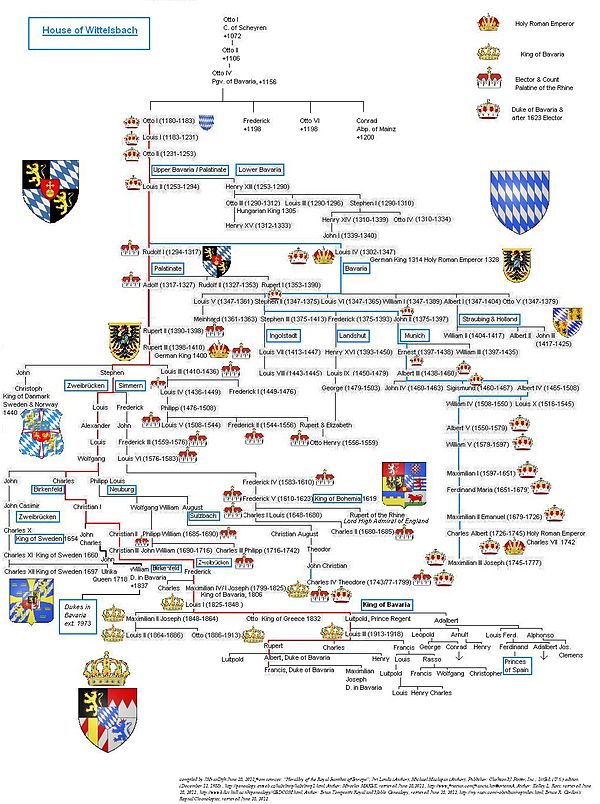
Living legitimate members of the House of Wittlesbach
[edit]Bold signifies heads of the house and numbers shown indicate the pretense to the kingship of Bavaria:
 Ludwig I of Bavaria (1786–1868)
Ludwig I of Bavaria (1786–1868)
 Maximilian II of Bavaria (1811–1864)
Maximilian II of Bavaria (1811–1864)
 Ludwig II of Bavaria (1845–1886)
Ludwig II of Bavaria (1845–1886) Otto of Bavaria (1848–1916)
Otto of Bavaria (1848–1916)
- Princess Mathilde Caroline of Bavaria (1813–1863), married Louis III, Grand Duke of Hesse (1806-1877) without issue
- Prince Otto of Bavaria, later King of Greece, (1815–1867), married Princess Amalia of Oldenburg (1818–1875) without issue
- Princess Theodelinde of Bavaria (1816–1817)
 Luitpold, Prince Regent of Bavaria (1821–1912)
Luitpold, Prince Regent of Bavaria (1821–1912)
 Ludwig III of Bavaria 1845–1921
Ludwig III of Bavaria 1845–1921
 Rupprecht, Crown Prince of Bavaria (1869–1955)
Rupprecht, Crown Prince of Bavaria (1869–1955)
- Prince Luitpold of Bavaria (1901–1914)
- Princess Irmingard of Bavaria (1902–1903)
 Albrecht, Duke of Bavaria (1905–1996)
Albrecht, Duke of Bavaria (1905–1996)
- Princess Marie Gabrielle of Bavaria (born 1931), married Georg, Prince of Waldburg zu Zeil und Trauchburg (1928–2015) and has issue
- Princess Marie Charlotte of Bavaria (1931–2018), married Paul, Prince of Quadt zu Wykradt und Isny (1930–2011) and issue
 Franz, Duke of Bavaria (born 1933), head of the House of Wittelsbach (1996–present)
Franz, Duke of Bavaria (born 1933), head of the House of Wittelsbach (1996–present)- (1) Prince Max-Emanuel, Duke in Bavaria (born 1937)
- Princess Sophie of Bavaria (born 1967), married Alois, Hereditary Prince of Liechtenstein (born 1968) and has issue
- Princess Marie Caroline of Bavaria (born 1969), married Duke Philipp of Württemberg (born 1964) and has issue
- Princess Helene of Bavaria (born 1972)
- Princess Elisabeth of Bavaria (born 1973), married Daniel Terberger (born 1967) and has issue
- Princess Maria Anna of Bavaria (born 1975), married twice and has issue
- Prince Rudolf of Bavaria (1909–1912)
- Prince Heinrich of Bavaria (1922–1958), married Anne Marie de Lustrac (1927–1999) without issue
- Princess Irmingard of Bavaria (1923–2010), married Prince Ludwig of Bavaria (1913–2008), see issue below
- Princess Editha of Bavaria (1924–2013), married twice and has issue
- Princess Hilda of Bavaria (1926–2002), married Juan Bradstock Edgar Lockett de Loayza (1912–1987) and had issue
- Princess Gabriele of Bavaria (1927–2019), married Carl Emmanuel, 14th Duke of Croÿ (1914–2011) and had issue
- Princess Sophie of Bavaria (born 1935), married Jean, 12th Duke of Arenberg (1921–2011) and has issue
- Princess Adelgunde of Bavaria (1870–1958), married William, Prince of Hohenzollern (1864–1927) without issue
- Princess Maria Ludwiga Theresia of Bavaria (1872–1954), married Prince Ferdinand Pius, Duke of Castro (1869–1960) and had issue
- Prince Karl of Bavaria (1874–1927)
- Prince Franz of Bavaria (1875–1957)
- Prince Ludwig of Bavaria (1913-2008)
- (2) Prince Luitpold of Bavaria (born 1951)
- Princess Auguste of Bavaria (born 1979), married Hereditary Prince Ferdinand of Lippe-Weißenfeld (born 1976) and has issue
- Princess Alice of Bavaria (born 1981), married Prince Lukas of Auersperg (born 1981) and has issue
- (3) Prince Ludwig of Bavaria (born 1982)
- (4) Prince Rupprecht of Bavaria (born 2024)
- (5) Prince Heinrich of Bavaria (born 1986)
- (6) Prince Maximilian of Bavaria (born 2021)
- (7) Prince Luitpold of Bavaria (born 2023)
- (8) Prince Karl of Bavaria (born 10 March 1987)
- Princess Maria of Bavaria (1953-1953)
- Princess Philippa of Bavaria (1954–1953)
- (2) Prince Luitpold of Bavaria (born 1951)
- Princess Maria Elisabeth of Bavaria (1914–2011), married Prince Pedro Henrique of Orléans-Braganza (1909–1981) and had issue – including the current Head of the Imperial House of Brazil
- Princess Adelgunde of Bavaria (1917–2004), married Baron Zdenko von Hoenning-O'Caroll (1906–1996) and had issue
- Princess Eleonore of Bavaria (1918–2009), married Count Konstantin of Waldburg-Zeil (1909–1972) and had issue
- Princess Dorothea of Bavaria (1920–2015), married Archduke Gottfried of Austria (1902–1984) and had issue
- Prince Rasso of Bavaria (1926-2011)
- Princess Maria Theresa of Bavaria (born 1956), married Count Tamбs Kornis de Gцncz-Ruszka (born 1949) and has issue
- Prince Franz-Josef of Bavaria (1957–2022)
- Princess Elisabeth of Bavaria (born 1959), married Count Andreas von Kuefstein (born 1954) and has issue
- (9) Prince Wolfgang of Bavaria (born 1960)
- (10) Prince Tassilo of Bavaria (born 1992)
- (11) Prince Richard of Bavaria (born 1993)
- (12) Prince Philip of Bavaria (born 1996)
- Princess Flavia of Bavaria (born 2011)
- Princess Benedikta of Bavaria (born 1961), married Count Rudolf von Freyberg-Eisenberg (born 1958) and has issue
- (13) Prince Christoph of Bavaria (born 1962)
- (14) Prince Corbinian of Bavaria (born 1996)
- (15) Prince Stanislaus of Bavaria (born 1997)
- (16) Prince Marcello of Bavaria (born 1998)
- Princess Odilia of Bavaria (born 2002)
- Princess Gisela of Bavaria (born 1964), married Prince Alexander of Saxony (born 1954) and has issue
- Prince Ludwig of Bavaria (1913-2008)
- Princess Mathilde of Bavaria (1877–1906), married Prince Ludwig Gaston of Saxe-Coburg and Gotha (1870–1942) and had issue
- Prince Wolfgang of Bavaria (1879–1895)
- Princess Hildegard of Bavaria (1881–1948)
- Princess Notburga of Bavaria (1883-1883)
- Princess Wiltrud of Bavaria (1884–1975), married Wilhelm Karl, Duke of Urach (1864–1928) without issue
- Princess Helmtrud of Bavaria (1886–1977)
- Princess Dietlinde of Bavaria (1888–1889)
- Princess Gundelinde of Bavaria (1891–1983), married Count Johann Georg of Preysing-Lichtenegg-Moos (1887–1924) and had issue
- Prince Leopold of Bavaria (1846–1930)
- Princess Elisabeth Marie of Bavaria (1874–1957), married Count Otto of Seefried and Buttenheim (1870–1951) and had issue
- Princess Auguste of Bavaria (1875–1964), married Archduke Joseph August of Austria (1872–1962) and had issue
- Prince Georg of Bavaria (1880–1943), married Archduchess Isabella of Austria (1888–1973) without issue
- Prince Konrad of Bavaria (1883–1969)
- Princess Amalie Isabella of Bavaria (1921–1985), married Count Umberto Poletti Galimberti, Count di Assandri (1921–1995) and had issue
- Prince Eugen of Bavaria (1925–1997), married Countess Helene von Khevenhüller-Metsch (1921–2017) without issue
- Princess Therese of Bavaria (1850–1925)
- Prince Arnulf of Bavaria (1852–1907)
- Prince Heinrich of Bavaria (1884–1916)
- Princess Adelgunde of Bavaria (1823–1914), married Francis V, Duke of Modena (1819–1875) and had issue
- Princess Hildegard of Bavaria (1825–1864), married Archduke Albrecht, Duke of Teschen (1817–1895) and had issue
- Princess Alexandra of Bavaria (1826–1875)
- Prince Adalbert of Bavaria (1828–1875)
- Prince Ludwig Ferdinand of Bavaria (1859–1949)
- Prince Ferdinand of Bavaria (1884–1958), married twice and renounced his rights to the Bavarian throne in 1914
- Prince Adalbert of Bavaria (1886–1970)
- Prince Konstantin of Bavaria (1920–1969)
- (17) Prince Leopold of Bavaria (born 1943)
- (18) Prince Manuel of Bavaria (born 1972)
- (19) Prince Leopold of Bavaria (born 2007)
- Princess Alva of Bavaria (born 2010)
- (20) Prince Gabriel of Bavaria (born 2014)
- (21) Prince Joseph of Bavaria (born 2019)
- Princess Maria del Pilar of Bavaria (born 1978)
- Princess Maria Felipa of Bavaria (born 1981), married Christian Dienst (born 1978) and has issue
- (22) Prince Konstantin of Bavaria (born 1986)
- (23) Prince Alexis of Bavaria (born 2020)
- (24) Prince Nikolaus of Bavaria (born 2023)
- (18) Prince Manuel of Bavaria (born 1972)
- (25) Prince Adalbert of Bavaria (born 1944)
- Princess Bernadette of Bavaria (born 1986), married Carmelo Milici (born 1987) and has issue
- (26) Prince Hubertus of Bavaria (born 1989)
- Princess Ysabel of Bavaria (born 1954), married Count Alfred Hoyos (born 1951) and has issue
- (17) Prince Leopold of Bavaria (born 1943)
- Prince Alexander of Bavaria (1923–2001)
- Prince Konstantin of Bavaria (1920–1969)
- Prince Alfons of Bavaria (1862–1933)
- Prince Joseph Clemens of Bavaria (1902–1990)
- Princess Elisabeth of Bavaria (1913–2005), married twice and had issue
- Princess Isabella of Bavaria (1863–1924), married Prince Tommaso, Duke of Genoa (1854–1931) and had issue
- Princess Elvira of Bavaria (1868–1943), married Count Rudolf von Wrbna-Kaunitz-Rietberg-Questenberg und Freudenthal (1864–1927) and had issue
- Princess Clara of Bavaria (1874–1941)
- Prince Ludwig Ferdinand of Bavaria (1859–1949)
Gallery of the Bavarian Kings
[edit]-
Max I. Joseph (1806–1825)
-
Ludwig I. (1825–1848)
-
Maximilian II. (1848–1864)
-
Ludwig II. (1864–1886)
-
Prinzregent Luitpold (1886–1912)
-
Ludwig III. (1913–1918)
Castles and palaces
[edit]Bavaria
[edit]Some of the most important Bavarian castles and palaces that were built by Wittelsbach rulers, or served as seats of ruling branch lines, are the following:
-
The Old Court in Munich
-
Nymphenburg Palace in Munich
-
Schleissheim Palace in Munich
-
Trausnitz Castle in Landshut
-
Straubing Castle
-
Herrenchiemsee Palace
Palatinate branch
[edit]Some of the most important castles and palaces of the Palatinate Wittelsbach were:
-
Heidelberg Castle 1670
-
Benrath Mansion in Düsseldorf
-
Bensberg Castle
-
Birkenfeld Castle 1645
-
Sulzbach Castle
-
Neumarkt Castle
-
Simmern Castle 1648
Electorate of Cologne
[edit]From 1597 to 1794, Bonn was the capital of the Electorate of Cologne and residence of the Archbishops and Prince-electors of Cologne, most of them belonging to the Bavarian branch of the House of Wittelsbach (continuously from 1583 to 1761).
-
Electoral Palace, Bonn
-
Poppelsdorf Palace, Bonn
-
Augustusburg Palace, Brühl
Coats of arms
[edit]A full armorial of the Wittelsbach family can be found on the French-language Wikipedia at Armorial of the House of Wittelsbach.
Origins
[edit]| Armoiries | Écu | Nom et blasonnement |
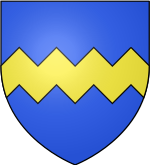
|
House of Scheyern
De gueules, à fasce vivrée d'argent. Cimier: un chapeau piramidal aux armes de l'ècu, retrousseré d'argent, sommé d'une plume d'autruche de même. (azure, a golden fess dancetty)[27] | |

|
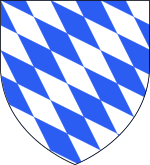
|
House of Wittelsbach The "strikingly simple and beautiful" arms of Wittelsbach were taken from the arms of the counts of Bogen, who became extinct in 1242. When Louis I married Ludmilla, the widow of Albert III, Count of Bogen, he adopted the coat of arms of the counts of Bogen together with their land, along the Danube between Regensburg and Deggendorf. The first members of the family to use the arms were that Louis I/Ludwig and Heinrich, who were the sons of first Wittelsbach Duke of Bavaria, Otto I. They used the arms in their seals around 1240. The arms have ever since been the arms of the family. The number of lozenges varied; from the 15th century 21 were used, increasing to 42 when Bavaria became a kingdom in 1806.[27]
Fuselé en bande d'azur et d'argent.[30] |
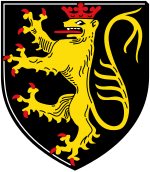 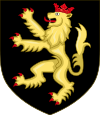
|
Count Palatine of the Rhine from 1215.
de sable, au lion d'or, armé, lampassé et couronné de gueules et en 2 et 3 fuselé en bande d'azur et d'argent.[31] [Inconsistent with the image, which is not quartered with the Bavarian arms] The Count Palatine was also an Electoral Prince of the Empire, with the title of arch-seneschal of the Empire, as symbolized by : gueules à l'orbe d'or cerclée de même.[32] |
Grand Offices of the Prince Electors of the House of Wittelsbach (Erzämter)
[edit]Each of the prince electors carried one of the grand offices of the Empire. Each office was indicated by a heraldic mark; the ones that the House of Wittelsbach carried are shown below.
| Office and titles | Mark of office | Holder | Blazon (of mark of office) |
|---|---|---|---|
| Arch-Senechal (Arch-Steward) of the Empire (Count Palatine of the Rhine from 1329 to 1623 and 1706 to 1714, plus Dukes of Bavaria from 1623 to 1706 and after 1714) |
 
|

|
De gueules à l'orbe d'or.[citation needed] |

| |||
| Arch-treasurer of the Empire (Count Palatine of the Rhine from 1652 to 1706 and from 1714 to 1777, plus House of Hanover from 1710 to 1714 and after 1777) |
 
|

|
De gueules à la couronne de Charlemagne d'or.[citation needed] |

|
Palatinate branch (senior line), issue of Rudolph I of the Palatinate and Bavaria
[edit]In the German fashion, all the sons were "Count Palatine of the Rhine" (German: Pfalzgraf bei Rhein). There was only one Elector Palatine of the Rhine (German: Kurfürst von der Pfalz). Similarly, all the sons were Dukes of Bavaria (German: Herzog von Bayern), until 1506. Then, Duke in Bavaria (German: Herzog in Bayern) was the title used by all members of the House of Wittelsbach with the exception of the Duke of Bavaria. This became a unique position given to the eldest descendant of the younger branch of the Wittelsbachs, who inherited the rule of the entire duchy of Bavaria. For example, so reads the full title of the late 16th century's Charles I, Count Palatine of Zweibrücken-Birkenfeld and patriarch of the House of Palatinate-Birkenfeld: "Count Palatine by Rhine, Duke in Bavaria, Count at Veldenz and Sponheim" (Pfalzgraf bei Rhein, Herzog in Bayern, Graf zu Veldenz und Sponheim).
| Figure | Name of armiger and blazon |
|---|---|
 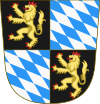
|
Electoral Palatinate, County Palatine of the Rhine from 1215 to 1623.
Quarterly 1 and 4 sable, a lion or, armed, langued and crowned gules, 2 and 3 fusilly bendwise azure and argent.[31] Heraldic augmentation for the Count Palatine of the Rhine, a prince-elector of the Holy Roman Empire: Quarterly 1 and 4 sable, a lion or, armed, langued and crowned gules, 2 and 3 fusilly bendwise azure and argent, overall gules, an orb or encircled of the same.[32] |

|
Electoral Palatinate, County Palatine of the Rhine from 1215 to 1623.
Coat of arms (15th century), the Wittelsbach (Bogen) lozenges quartered with the lion of the Palatinate. |
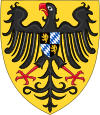
|
Rupert of Germany (1352 † 1410), king of the Romans from 1400 to 1410.
Or, an eagle sable, membered, beaked and langued gules; overall quarterly 1 and 4 sable, a lion or, armed, langued and crowned gules, 2 and 3 fusilly bendwise azure and argent.[33] |
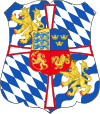
|
Christopher of Bavaria (1416 † 1448), king of Denmark, Norway and Sweden
Quarterly a cross paty argent, fimbriated gules, cantonned 1 and 4, azure three bars wavy argent, overall a lion crowned or, which is Sweden ancien, 2 and 3 fusilly bendwise argent and azure, which is Bavaria. Overall quarterly 1 or, nine hearts gules in three pallets, three lions passant guardant azure in pale, armed and langued gules, crowned of the field, brochant sur-le-tout, which is Denmark, 2 azure, three crowns or, which is Sweden moderne, 3 gules, a lion crowned or, holding in his paws a battle-axe argent, the handle of the second, which is Norway ancien and 4 gules, a dragon or, which is for the Kingdom of the Vandals[34] |

|
Stephen, Count Palatine of Simmern-Zweibrücken (1385 † 1459), Count Palatine of Simmern-Zweibrücken
Quarterly 1 and 4 sable, a lion or, armed, langued and crowned gules (Palatinate), 2 and 3 fusilly bendwise azure and argent (Bavaria), overall an inescutcheon Chequy or and azure (Simmern)[35] |

|
Counts Palatine of Veldenz
Quarterly 1 and 4 sable, a lion or, armed, langued and crowned gules (Palatinate), 2 and 3 fusilly bendwise azure and argent (Bavaria), overall an inescutcheon d'argent a lion d'azur, with a couronné d'or [36] |

|
Counts of Palatinate–Birkenfeld (1584–1717)
Quarterly 1 sable, a lion or, armed, langued and crowned gules (Palatinate), 2 fusilly bendwise azure and argent (Bavaria), 3 a lion azure crowned or (Veldenz), 4 Chequy gules and azure (Birkenfeld).[image is chequy gules and argent][37] |
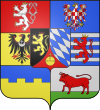 
|
Frederick V, Elector Palatine (1596 † 1632), elector palatine from 1610 to 1623 and king of Bohemia from 1619 to 1620.
Quarterly of six, three rows of two, 1 gules, a lion argent, queue fourchée in saltire, crowned, armed and langued or (Bohemia), 2 azure, an eagle chequy of argent and gules, beaked, langued, membered and crowned or (Moravia), 3 or, an eagle sable, armed, beaked and langued gules, on its heart a crescent below a cross argent (Silesia), 4 barry of six argent and azure, a lion gules, queue fourchée in saltire, armed, langued and crowned or (Luxembourg), 5 per fess embattled azure and or (Upper Lusace), 6 argent, a bull gules issuant from a terrace vert (Lower Lusace). Overall per pale sable, a lion or, armed, langued and crowned gules (Palatinate) and fusilly bendwise azure and argent (Bavaria); grafted in point gules, an orb or, which is the heraldic augmentation for the archsteward of the Holy Roman Empire.[38] |
 
|
Counts Palatine of the Rhine from 1648 to 1688.
Quarterly 1 and 4 sable, a lion or, armed, langued and crowned gules (Palatinate), 2 and 3 fusilly bendwise azure and argent (Bavaria), overall gules, a crown of Charlemagne or, which is the heraldic augmentation for the archtreasurer of the Holy Roman Empire.[39] |

|
Counts palatine of Neuburg from 1574 to 1688. Counts palatine of Sulzbach from 1688 to 1795. Quarterly of eight, two rows of four, 1 fusilly bendwise azure and argent (Bavaria), 2 or, a lion sable, armed and langued gules (Juliers), 3 gules, an escutcheon argent surmounted by an escarbuncle with rays or (Cleves), 4 argent, a lion gules, queue fourchée in saltire, armed, langued and crowned or (Berg), 5 argent, a lion azure armed, langued and crowned or (Veldenz), 6 or, a fess chequy argent and gules of three rows (de la Marck), 7 argent, three chevrons gules (Ravensberg), 8 argent, a fess sable. Overall, a lion or, armed, langued and crowned gules (County palatine of the Rhine).[citation needed] |
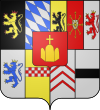
|
Electors palatine of Neuburg from 1688 to 1742.
Per pale, I quarterly 1 sable, a lion or, armed, langued and crowned gules (county palatine of the Rhine), 2 fusilly bendwise azure and argent (Bavaria), 3 argent, a lion azure armed, langued and crowned or (Veldenz), 4 or, a fess chequy of three rows argent and gules (de la Marck), II per fess, the chief tierced in pale, the base per pale: 1, or, a lion sable, armed and langued gules (Juliers), 2 gules, an escutcheon argent, surmounted by an escarbuncle with rays or (Cleves), 3 argent, a lion gules, queue fourchée in saltire, armed, langued and crowned or (Berg); 4 argent, three chevrons gules (Ravensberg), 5 argent, a fess sable. Overall gules, a crown of Charlemagne or (Arch-treasurer of the Holy Roman Empire).[citation needed] |

|
Counts palatine of Zweibrücken from 1569 to 1675 Palatine Zweibrücken
Per pale, I quarterly 1 and 4 sable, a lion or, armed, langued and crowned gules (county palatine of the Rhine), 2 and 3 fusilly bendwise, azure and argent (Bavaria); overall argent, a lion azure armed, langued and crowned or (Veldenz); II quarterly of six, two rows of three, 1 or, a lion sable, armed and langued gules (Juliers), 2 gules, an escutcheon argent, surmounted by an escarbuncle with rays or (Cleves), 3 argent, a lion gules, queue fourchée in saltire, armed, langued and crowned or (Berg), 4 or, a fess chequy of three rows, argent and gules (de la Marck), 5 argent, three chevrons gules (Ravensberg), 6 argent, a fess sable.[citation needed] |
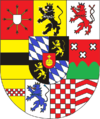
|
Electorate of Bavaria under Charles Theodore, Elector of Bavaria, 1777–1799
1. duchy of Cleve, 2. duchy of Jülich, 3. duchy of Berg, 4. principality of Moers, 5. heart, 6. markgraviat of Bergen op Zoom, 7. county of Mark, 8a. county of Veldenz, 8b. county of Sponheim, 9. county of Ravensberg, heart: duchy of Bavaria and Palatinate, electorate. |

|
Electorate of Bavaria under Maximilian I Joseph of Bavaria, 1799–1804
Grand quarters 1: Or a lion Sable with a forked tail in saltire armed and langued Gules, crowned Or (which is from Juliers) in 2, Argent a lion Gules, a forked tail in saltire, armed, langued and crowned Azure (which is of Berg), in 3, Gules, an escutcheon Argent, carbuncle rays Or, debruising over all (which is of Cleves) , in 4, Or a fess Sable (which of the County of Sponheim), in 5, checky Argent and Gules of three tires (which is of Birkenfeld), in 6 Gules, three mountain Vert charged of three silver crosses in saltire (which is from Bergen op Zoom), in 7, Argent with a lion Azure crowned Or (which is from the County of Veldenz, in 8, Or, a fess checkered argent and gules of three tires (which is from la Marck), in 9, argent, three coats of arms gules (2 and 1) (which is from Ribeaupierre), in 10, argent, three chevrons gules (which is from Ravensberg), in 11, argent three-headed eagle sable crowned or 2 and 1 (which is from the Principality of Waldeck-Pyrmont, over all, quarterly in 1 and 4 Sable, a lion Or, armed and langued and crowned Gules (which is of the County Palatine of the Rhine) and 2 and 3 tapering in bend Azure and Argent (which is of Bavaria), on the all from gules to orb d'or.[40];.[41];[42] |

|
Electorate of Bavaria under Maximilian I Joseph of Bavaria, 1804–1806
Per pale in 1: Azure, to the penon quarterly Argent and Gules, the shaft Or and Argent and Gules of three pieces (which is of the Bishopric of Würzburg), in 2, Argent a lion Gules, the forked tail in saltire, armed, langued and crowned Azure (which is of Berg), in 3, Gules, an escutcheon Argent, carbuncle rays Or, debruising over the whole (which is of Cleves), in 4, Or a lion Sable armed and langued Gules a stick Argent debruising over the whole (which is of the Archdiocese of Bamberg), in 5, parti gules and argent (which is of the abbey of Augsburg, in 6, per fess gules and azure on the head of a princess crowned or (which is of the abbey of Kempten, in 7, d argent a Moor's head neck and earring Gules, crowned Or (which is of Freising Abbey), in 8, argent a wolf Gules (which is of the Abbey of Passau), in 9, Argent a fess Azure (which is of Leuchtenberg), in 10, Per fess in 1 Gules an elephant Argent and in 2 Or (which is of County Helfenstein ), 11, argent, three chevrons gules (which is Ravensberg), 12, argent a mounting three peaks vert surmounted by a lion gules armed and langued also gules (which is of Mindeheim), 13, Or, a fess chequered Argent and Gules of three rows (which is of the Marck), 14, Gules a half-headed eagle Argent (which is of Ottobeuren Abbey ), 15, Argent to the castle with two towers Gules (which is of Rothenburg), over all, quarterly in 1 and 4 Sable, to the lion Or, armed and langued and crowned Gules (which is of County Palatine of the Rhine) and in 2 and 3 tapered in bend Azure and Argent (which is of Bavaria), over all Gules an orb Or..[43] |
 
|
Kings of Sweden from 1654 to 1720 (from the Counts Palatine of Zweibrücken-Kleeburg a sub-cadet branch of the Counts Palatine of Zweibrücken)
Quarterly, a cross paty or, which is the cross of Saint Eric, cantonned 1 and 4, azure, three crowns or, two and one (Sweden moderne), 2 and 3 azure, three bars wavy argent, a lion crowned or, armed and langued gules (Sweden ancien). Overall quarterly Bavaria, Juliers, Cleves and Berg, inescutcheon sable, a lion or, armed, langued and crowned gules (County palatine of the Rhine).[44] |

|
Counts palatine of Birkenfeld from 1569 to 1795.
Per pale, I quarterly 1 and 4 County palatine of the Rhine, 2 and 3 Bavaria; II quarterly 1 Veldenz, 2 chequy gules and argent (de Birkenfeld), 3 argent, three escutcheons gules, two and one (Rappolstein), 4 argent, three heads of eagles sable, crowned or, two and one (de Hohenach).[citation needed] |
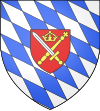
|
King of Bavaria from 1809 to 1835.
Fusilly bendwise, azure and argent, an inescutcheon gules, a sword argent pommelled or and a scepter or in saltire, in chief a royal crown or[32] |

|
Kings of Bavaria from 1835 to 1918 (see Coat of arms of Bavaria).
Quarterly 1 sable, a lion or, armed, langued and crowned gules (County palatine of the Rhine), 2 per fess indented gules and argent (the "Franconian Rake") for the northern parts of Bavaria that were part of the stem duchy of Franconia, 3 bendy sinister argent and gules, a pale or (markgraviate of Burgau representing those lands that were part of the stem duchy of Swabia), 4 argent, a lion azure, armed, langued and crowned or (Veldenz) representing the lands on the middle Rhenish Palatinate were this branch of the Wittelsbachs originated. Overall, Bavaria.[32] |
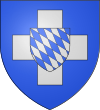
|
Otto de Wittelsbach (1815 † 1867), king of Greece.
Azure, a cross couped argent, inescutcheon Bavaria.[45] |

|
Dukes in Bavaria after 1834.
Paly-bendy azure and argent. |
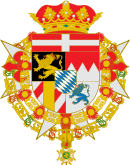
|
Prince Ferdinand of Bavaria (1884–1958), Infante of Spain branch of "Wittelsbach-Bourbon» Quarterly, County Palatine of the Rhine, Franconia, de Burgovie, de Veldenz. Inescutcheon, Bavaria. In chief, gules, a cross argent. |
Bavarian branch (junior branch), issue of Louis of Bavaria, extinct by 1777
[edit]| Figure | Name of armiger and blazon |
|---|---|

|
Dukes of Bavaria from 1180 to 1623.
Fusilly in bend azure and argent[32] |
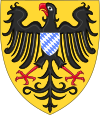
|
Louis IV (1286 † 1347), king of the Romans in 1314, emperor of the Holy Roman Empire in 1328.
Or, an eagle sable, membered, beaked and langued gules, inescutcheon fusilly in bend azure and argent.[33] |
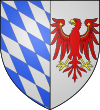
|
Dukes of Bavaria and Electors of Brandenburg : Louis V († 1361), Louis VI († 1365) and Otto V († 1379).
Per pale fusilly in bend azure and argent, and argent, an eagle gules, armed, beaked and langued or.[citation needed] |
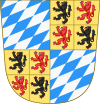
|
Duke of Bavaria-Straubing, Counts of Hainaut and Holland from 1254 to 1433.
Quarterly 1 and 4, fusilly in bend, azure and argent, 2 and 3, grand-quarterly I and IV or, a lion sable, armed and langued gules, II and III, or, a lion gules, armed and langued azure.[46] |

|
Electors of Bavaria from 1623 to 1777.
In 1620, the Elector Palatine Frederick V, a Protestant, was defeated after trying to take the kingdom of Bohemia. He was placed under the ban of the Empire and his lands, titles and electoral dignity were confiscated and given to his Roman Catholic cousin, the Duke of Bavaria, who takes: Quarterly 1 and 4 fusilly in bend, azure and argent, 2 and 3 sable, a lion or, armed, langued and crowned gules, overall gules, an orb crucifer or.[33] |
 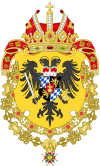
|
Charles VII (1697 † 1745), Holy Roman Emperor from 1742 to 1745.
Or, an eagle sable, membered, beaked and langued gules; inescutcheon quarterly 1 and 4 fusilly in bend, azure and argent, 2 and 3 sable, a lion or, armed, langued and crowned gules, sur le tout gules, an orb crucifer or.[33] |
See also
[edit]
- Kings of Germany family tree
- List of rulers of Bavaria
- List of rulers of the Palatinate
- Asteroid 90712 Wittelsbach, named in the castle and dynasty's honour
- Wittelsbach Diamond
- Monarchism in Bavaria after 1918
- List of coats of arms with the Palatine Lion
Notes
[edit]- ^ Goodey, Emma (17 March 2016). "Succession". The Royal Family.
- ^ Rodrigues, Ana Maria S. A.; Silva, Manuela Santos; Spangler, Jonathan W. (19 August 2019). Dynastic Change: Legitimacy and Gender in Medieval and Early Modern Monarchy. ISBN 9781351035125.
- ^ Germany: Bavaria: Heads of State: 1806–1918 archontology.org, accessed: 14 June 2008
- ^ Manfred Berger (2003). "Rupprecht, Maria Luitpold Ferdinand, Kronprinz von Bayern, Pfalzgraf bei Rhein, Herzog von Bayern, Franken und in Schwaben usw.". In Bautz, Traugott (ed.). Biographisch-Bibliographisches Kirchenlexikon (BBKL) (in German). Vol. 22. Nordhausen: Bautz. cols. 1173–1186. ISBN 3-88309-133-2.
- ^ "house of Wittelsbach | Facts & History". Encyclopedia Britannica. Retrieved 2021-10-05.
- ^ Sun, Baltimore. "Duke Albrecht of Bavaria,91, who survived Nazi..." baltimoresun.com. Retrieved 2021-10-05.
- ^ Franz von Bayern (with Marita Krauss): Zuschauer in der ersten Reihe: Erinnerungen (Front row audience: memories), publisher C. H. Beck, 2023, pp. 5–28
- ^ Website of Wittelsbacher Ausgleichsfonds (Wittelsbach Compensation Fund), in German
- ^ The board usually consists of the head of the House of Wittelsbach, the Bavarian Minister of Education, Sciences and Arts, and the General Director of the Bavarian State Painting Collections.
- ^ Tagesschau (German TV programme): Die Wittelsbacher und ihre heutige Rolle: "Ehrgeiz für Bayern" (The Wittelsbachers and their role today: “Ambition for Bavaria”)
- ^ Wittelsbach Compensation Fund, website (in German)
- ^ Heirs of the Bavarian kings still collect millions (German article in Süddeutsche Zeitung, 6 February 2016)
- ^ Francis of Bavaria (with Marita Krauss): Zuschauer in der ersten Reihe: Erinnerungen (Front row audience: memories), 2023, p. 178−181
- ^ Website of the European Foundation for the Imperial Cathedral of Speyer: Committees.
- ^ Goodey, Emma (17 March 2016). "Succession". The Royal Family. Retrieved 9 May 2019.
- ^ "George I". BBC History.
- ^ Duggan, Anne J., ed. Nobles and Nobility in Medieval Europe: Concepts, Origins, Transformations. Rochester, N.Y.: Boydell & Brewer, 2000.p.36.
- ^ Muller-Mertens 1999, p. 239.
- ^ *Warner, David, ed. (2001). Ottonian Germany: The Chronicon of Thietmar of Merseburg. Manchester University Press.
- ^ Lingelbach 1913, p. 89.
- ^ Detlev Schwennicke, Europäische Stammtafeln: Stammtafeln zur Geschichte der Europäischen Staaten, Neue Folge, Band I (Marburg, Germany: Verlag von J. A. Stargardt, 1980), Tafeln 9, 23
- ^ a b c Detlev Schwennicke, Europäische Stammtafeln: Stammtafeln zur Geschichte der Europäischen Staaten, Neue Folge, Band I (Marburg, Germany: Verlag von J. A. Stargardt, 1980), Tafel 23
- ^
Louda & c make Otto II the father of Otto IV
- ^ Wolfram Ziegler: König Konrad III. (1138–1152). Hof, Urkunden und Politik. Böhlau Wien, 2008, ISBN 978-3-205-77647-5, S. 472.
- ^ Jeffery 2018, p. ii.
- ^ Rietstap, Johannes Baptist (1861). Armorial général, contenant la description des armoiries des familles nobles et patriciennes de l'Europe: précédé d'un dictionnaire des termes du blason. G.B. van Goor. p. W. Archived from the original on 2023-05-10. Retrieved 2023-05-10.
De gueules, à la fasce vivrée d'argent. ...
- ^ a b c Biebel, Christoph (2006). "Das Wappen der Wittelsbacher" (PDF). Retrieved 2007-10-11.[dead link]
- ^ Biebel, Christoph (2006). "Das Wappen der Wittelsbacher" (PDF). Retrieved 2007-10-11.[dead link]
- ^ Maclagan & Louda 1999, p. 191
- ^ Rietstap, Johannes Baptist (1861). Armorial général, contenant la description des armoiries des familles nobles et patriciennes de l'Europe: précédé d'un dictionnaire des termes du blason. G.B. van Goor. p. W. Archived from the original on 2023-05-10. Retrieved 2023-05-10.
Fuselé en bande d'argent et d'azur.
- ^ a b BSB-CGM-1952.
- ^ a b c d e Héraldique Européenne : Baviève
- ^ a b c d Héraldique Européenne : empereurs Archived 2010-12-25 at the Wayback Machine.
- ^ Héraldique Européenne : Dannemark
- ^ Rodler, Hieronymus (1532), Coat of arms of Johann II, Count Palatine and Duke of Simmern, 1532, Georg Rüxner, Anfang, ursprüg, und herkomen des Thurniers inn Teutscher nation, [2nd ed.], Seimern 1532, fol.[ix] (verso), retrieved 2023-05-15
- ^ Rietstap, Johannes Baptist (1861). Armorial général, contenant la description des armoiries des familles nobles et patriciennes de l'Europe: précédé d'un dictionnaire des termes du blason. G.B. van Goor. p. Bavière (de). Archived from the original on 2023-05-10. Retrieved 2023-05-10.
Fuselé en bande d'argent et d'azur.
- ^ Rodewald, Heinrich (1927). Das Birkenfelder Schloß. Leben und Treiben an einer kleinen Fürstenresidenz 1584-1717. Birkenfeld: Erike.
as the arms of Count Palatine Georg Wilhelm of Birkenfeld
- ^ Héraldique Européenne : Bohême.
- ^ Par déduction. En 1648, le fils de Frédéric V recupère une partie des terres paternelles, le titre d'électeur, confisquées en 1623, et la charge d'archi-trésorier du Saint-Empire. Il paraît logique de penser qu'il ajoute l'écu de cette charge sur ses armes.
- ^ "Haus der Bayerischen Geschichte". hdbg.eu (in German). Retrieved 2023-04-23..
- ^ "Haus der Bayerischen Geschichte" (in German). Retrieved 2023-04-23.
- ^ "Digitale Bibliothek". daten.digitale-sammlungen.de (in German). Archived from the original on Jul 10, 2023. Retrieved 7 August 2023.
- ^ "Haus der Bayerischen Geschichte". hdbg.eu (in German). Retrieved 2023-04-23..
- ^ Héraldique Européenne : Suede
- ^ Héraldique Européenne : Grèce
- ^ Héraldique Européenne : Hainaut
References
[edit]- Héraldique Européenne.
- Family tree of the Counts of Scheyern-Wittelsbach-Dachau-Valley, from a lecture by Prof. Schmid: Bayern im Spätmittelalter, winter 1996/97
- Muller-Mertens, Eckhard (1999). "The Ottonians as kings and emperors". In Reuter, Timothy; McKitterick, Rosamond (eds.). The New Cambridge Medieval History: Volume 3, C.900-c.1024. Cambridge University Press.239
- Otto I at genealogie-mittelalter
- Otto II at genealogie-mittelalter (give a different date of death)
- Otto III at genealogie-mittelalter
- Lingelbach, William E. (1913). The History of Nations: Austria-Hungary. New York: P. F. Collier & Son Company. ASIN B000L3E368.
- Marek, Miroslav. "Genealogy of the House of Wittelsbach from Genealogy.eu". genealogy.euweb.cz (Genealogy.EU). Archived from the original on 2012-07-07. Retrieved 2007-05-27.
- Jeffery, Renée (2018). Princess Elisabeth of Bohemia: The Philosopher Princess. Lexington Books.
- Johannes Rietstap: Rietstap, Johannes Baptist (2003). Armorial general (in French). Vol. 2. Genealogical Publishing Co. ISBN 9780806304427.
- Johannes Rietstap: Rietstap, Johannes Baptist (1861). Armorial général, contenant la description des armoiries des familles nobles et patriciennes de l'Europe: précédé d'un dictionnaire des termes du blason (in French). G.B. van Goor.
- Johannes Rietstap: "On-line Armorial de J.B. RIETSTAP – et ses Compléments" (in French). Archived from the original on 9 December 2011. Retrieved 8 May 2019.
- Johannes Rietstap: Rietstap, Johannes Baptist (1875). Handboek der Wapenkunde (in Dutch). the Netherlands: Theod. Bom. p. 348.
- Maclagan, Michael; Louda, Jiří (1999) [1981]. Line of Succession: Heraldry of the Royal Families of Europe. London: Little, Brown & Co. pp. 188–194. ISBN 1-85605-469-1.
External links
[edit]- Haus Bayern – webpage of the Royal House of Bavaria (in German)
- Archived website about the Royal Family of Bavaria
- Haus Bayern – Wittelsbacher Ausgleichsfonds – Wittelsbach foundation (in German)
- Die Genealogie der Wittelsbacher – Genealogy of the Wittelsbach family (in German)






























































